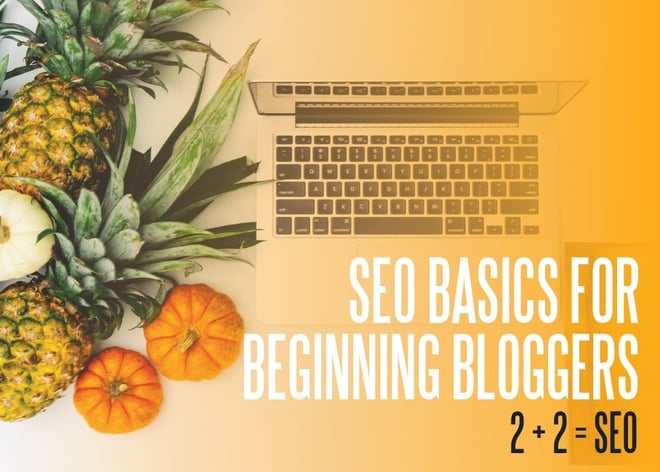Starting a new blog can be an exciting adventure.
A blog gives you a public platform to speak directly to your audience. However, with so many blogs on the web it can be difficult to stand out from the noise and secure traffic.
This is where SEO comes in.

Organic search directs the majority of traffic online, and you can capture some of that valuable traffic by optimizing your blog for search.
In this post I want to walk you through setting up a blog and optimizing it for search via SEO best practices.
Getting Started
Creating a blog only takes a few minutes and it couldn't be simpler, even for the most tech-shy among us.
First, you select a blog-publishing "host" such as:
There is nothing to download or install.
From the host's website, you create an account with your name, e-mail address and password. Next, you'll need to name your blog and select a template and color scheme that will determine how your blog will look.
After that, all that's left to do is start adding content to your blog.

Delivering valuable content to your audience is a large part of managing a successful blog, but you can't just publish content and expect your readers to find it.
You need to optimize your blog for search, and drive visitors to your content with proper SEO.
Optimizing your Blog
Even the best content in the world won't be successful if nobody reads it.
A proper SEO plan can help blogs improve their visibility in search. The main idea of creating a blog — other than providing information — is to get people to visit your site, and keep coming back.
If your blog follows SEO best practices, search engines will better understand your blog and it will have a better chance to rank.
If you're already writing great content on your blog, you'll want to ensure that content is visible with proper optimization. Below are some of the structural tips to building a blog and how it can be optimized for the most successful results from an SEO perspective.
1. Page Title
Only the first 60 characters of your page title will be displayed on Google.
Your page title should be a combination of intriguing and catchy. You can optimize your page title by including relevant keywords that describe the page. However, you don't want to stuff keywords into your page title (or in your blog post for that matter) for the sole purpose of optimization.
Your page title should clearly define what the page is about, so use keywords that are relevant to the page and to the phrases searchers might use to find it.
2. Meta Descriptions
Meta descriptions are the supplementary blocks of textual content that can are found below the meta title in search results.
It's worth noting that meta descriptions don't have a direct impact on SEO, but if you optimize them for users they will be more likely to click on your link. Click-throughs of your link WILL send positive signals to search engines.

These descriptions are limited to 160 characters before the text then isn't visible within the SERPs, meaning you need to be clear and concise in your meta descriptions. Your description should be a short summary outlining the purpose and usefulness of the article, and if it's compelling it can convince a searcher to click.
Again, include important keywords within your meta descriptions as these keywords will be highlighted in relevant searches.
3. Keywords
You should always consider what keywords you want your content to rank for when crafting content.
You shouldn't stuff keywords for SEO sake, but you want to be mindful of who you want to find your content and what they are searching for. Keywords help search engine crawlers know understand the text and identify how to index your content.
You can use Google's Adwords Keyword Planner tool to help identify potential keyword opportunities worth targeting with your content.
4. Header Tags
Header tags help search engines better understand the hierarchy of importance within your blog posts.
For example, H1 tags are typically used for the post's title, and should only be used once on a page. h1 tags are used at the top of the page and describe what the page is about.
Overusing the H1 tag is one of the biggest mistakes that blog owners make, and it confuses search engines which can affect search visibility.
However, H2 through H6 tags can be used multiple times on a page. These tags break up your content for it to be easily readable by search bots, and indicate the level of importance of the various sections within your blog posts.
5. Images and Alt Tags
Optimizing images is likely something you don't think about while building a blog, but image optimization is an important part of SEO.

Once you get the hang of it, image optimization is pretty straightforward. When using images, consider the size of the image as larger images can cause your site to load slower. Search engines put an emphasis on site speed, and slow load times can impact your blogs search rankings.
You should also use alt tags to tell search crawlers what your images are about. Alt tags help search engines better understand your images, which helps them better understand (and evaluate) your content as a whole.
6. Categories
Help your visitors navigate your blog easily by creating categories.
Search engines rate this feature as a plus for your blog and rank it possibly higher than others who don’t use that. Comparatively, if you order the blog posts chronologically, it is very hard for the bots to narrow them down and present the relevant ones to the reader, making categories a viable option.
7. Internal Linking
Internal linking is just as it sounds - linking to to other pages on your blog from your blog posts. This will benefit you because it helps improve navigation for readers by taking them to a relevant page, and helps keep visitors on your site.
Internal linking also helps spread link equity from external inbound links throughout your site. You want link equity to flow throughout your entire site as it will help your blog gain visibility overall, rather than just a few select pages.
Recap
Starting a blog is actually pretty easy; deciding what to blog about might be the biggest challenge.
Some people create their blogs as intimate journals. For others, they're a soapbox, opening up a virtual conversation with the world.
Regardless of the purpose your blog fulfills, you won't be successful if you can't attract a steady flow of visitors. Organic search is a massive marketing channel online, and you can tap into this channel with SEO.
If you're just starting out with your blog you don't have to get ultra-technical, but adhering to the basic principles of SEO will help your blog be more visible in search.
As a beginning blogger, make sure to optimize:
- Page titles.
- Meta descriptions.
- Keywords.
- Header tags.
- Images and Alt tags.
- Categories.
- And internal linking.
As a burgeoning blog don't expect an audience overnight. But through sound SEO practices you can gain traction in search and begin to bring more visitors to your site.
A few bonus tips for beginning bloggers:
- Post regularly and often: frequent updates give readers a reason to return to your blog and will help you find your voice.
- Give your blog a focus: whether it's knitting, cooking, pop culture or politics, specialized blogs tend to attract loyal readers.
- Create your own community: seek out blogs that deal with similar subjects and comment on their posts or create a blog roll linking to other blogs.

